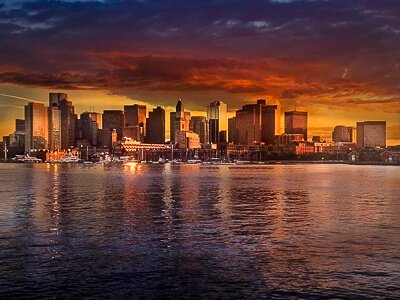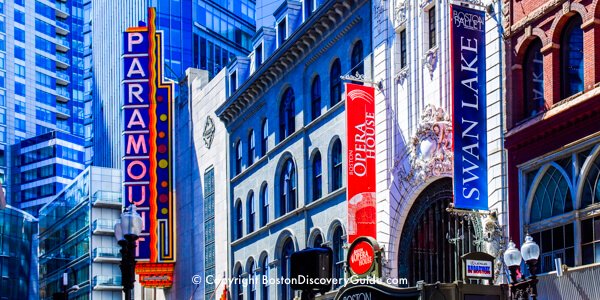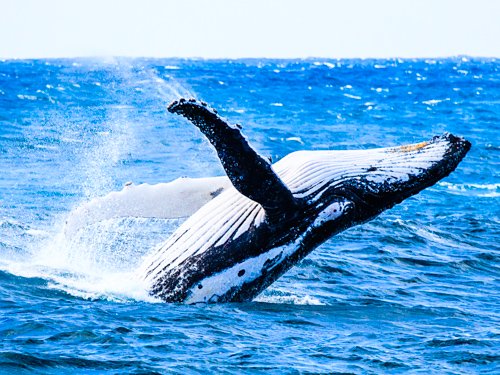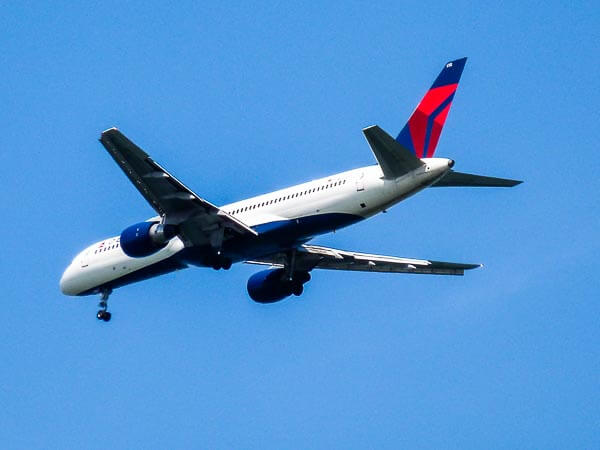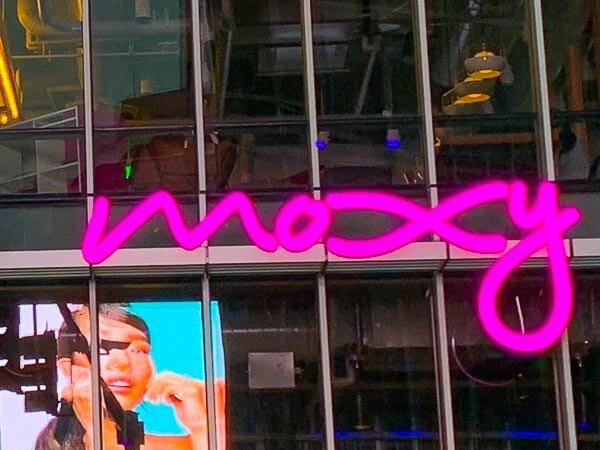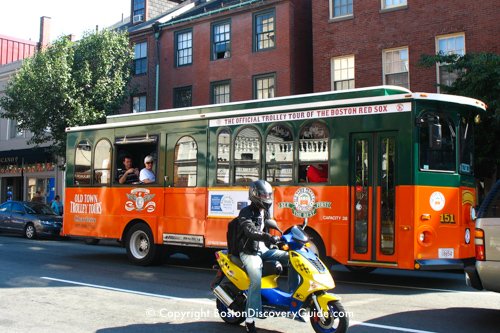As one of America's oldest cities, Boston has more than its share of war memorials honoring those whose sacrifices shaped American freedom. You will find most of these moving memorials conveniently located in the center of the city.
Acts of rebellion against the British here in Boston helped trigger the Revolutionary War.
The Boston Massacre, the Boston Tea Party, and the Battle at Bunker Hill all took place here. Cannons on top of Dorchester Hill convinced British ships to flee the Harbor, ending the Siege of Boston.
Local troops marched off to fight in the Civil War . . . World War I . . . World War II . . . Korea, Vietnam, Lebanon, Afghanistan, Iraq . . .
New types of conflicts mark the 21st century. The two planes flown into the Twin Towers on September 11, 2001 departed from Boston Logan Airport, carrying many local residents; 206 people from Massachusetts died in the attacks that day.
Two bombs exploded at the Boston Marathon on April 15, 2013, killing and grievously injuring our citizens. We shut down the city while our police battled and conquered the bombers in the streets.
If you're visiting Boston, you can see memorials honoring our fallen heroes and our history.
Take a moment to visit some of the special reminders of courage that commemorate Boston's commitment through the centuries to independence, freedom, civil rights, and equality.
Here are 15 war memorials and monuments to see when you visit Boston.
Some, such as the Bunker Hill Monument on the Freedom Trail, are famous and obvious in the landscape. Others are almost hidden, and you'll have to make an effort to find them.
All are worth seeing.
Bunker Hill Monument in Boston's historic Charlestown neighborhood, honoring those who died in the famous battle
Boston Discovery Guide is a reader-supported publication. When you buy through our links, we may earn a commission at no additional cost for you. Learn more
Boston Massacre Memorials
Commemorating the first casualties in the fight against British rule
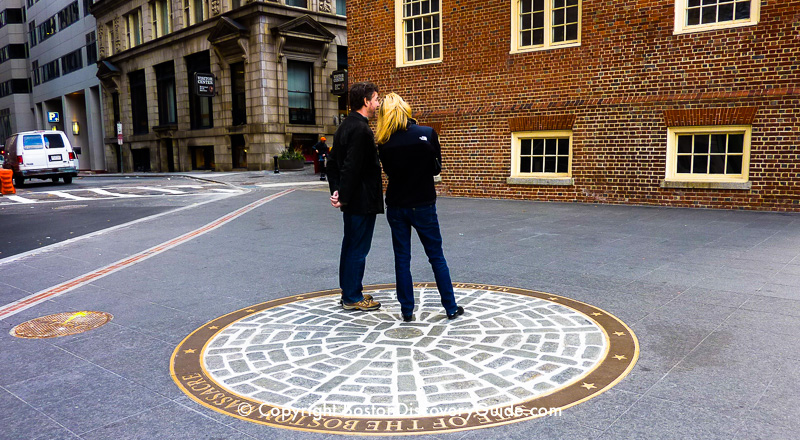
The Boston Massacre Memorial on the Freedom Trail is set into the pavement and marks the spot by the Old State House where five Colonists died during a skirmish against the British troops station in Boston. They are considered the first casualties in the fight for American freedom.
Did the Colonists provoke the Redcoats into firing during an alcohol-fueled street brawl on March 5, 1770? The British soldiers had orders not to shoot - but in the midst of the chaos, they fired almost point-blank. First to die was African American/Native American ex-slave Crispus Attucks. Five years later, the American Revolution began.
Boston Massacre Memorial location: On the Freedom Trail at the intersection of Devonshire and State Street, below the balcony on the east side of the Old State House
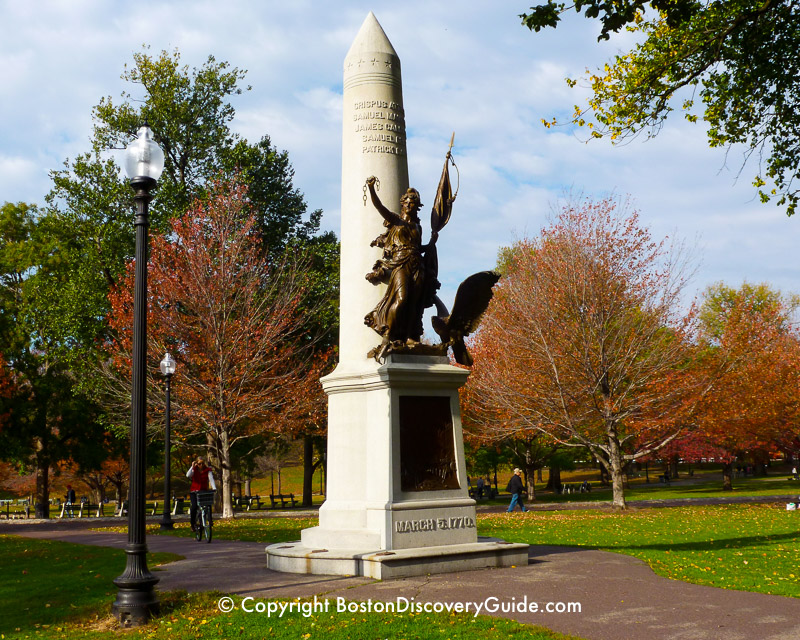
You can also find another monument, the Boston Massacre/Crispus Attucks Monument, on Boston Common honoring those who died in the Boston Massacre. and especially Crispus Attucks, the first to fall that night.
The 25-foot high pale granite column, erected in 1888, features a bronze figure representing the Spirit of the Revolution breaking the chains of tyranny and holding an American flag; for good measure, one of her feet crushes the British crown while at her other foot an eagle appears to be starting to fly.
Under the bronze figure, a bas-relief shows Crispus Attucks lying dead as British continue firing at Colonists by the Old State House - it may remind you of Paul Revere's engraving of the event.
Location: Boston Common, across from the intersection of Tremont and Avery Streets.
More about the Boston Massacre and Paul Revere's engraving
Bunker Hill Monument
Marking the first major battle of the American Revolution
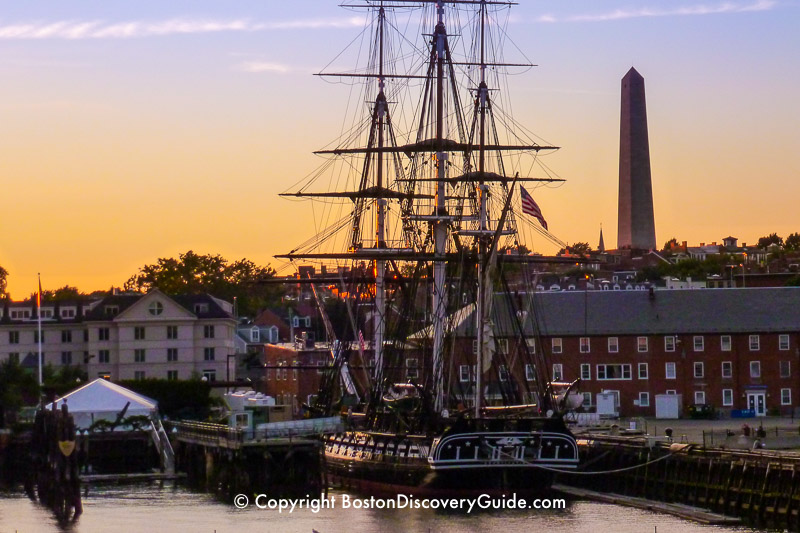
The Bunker Hill Monument commemorates a pivotal Revolutionary War battle that mostly took place on nearby Breed's Hill in Boston's Charlestown neighborhood.
The Battle of Bunker Hill took place on June 17, 1775, just a few months into the war against British rule. The badly equipped Colonial forces lost the battle - but they inflicted far more casualties than they sustained. For the first time, the British began to regard the Colonial troops as a serious threat.
Bunker Hill Monument location: On the Freedom Trail at Monument Square in Charlestown (just look for it - you really can't miss the 221 foot granite obelisk soaring high above the landscape)
More information about the Freedom Trail
Freedom Trail Tour information and tickets:
Civil War Memorials
Commemorating bravery and sacrifice
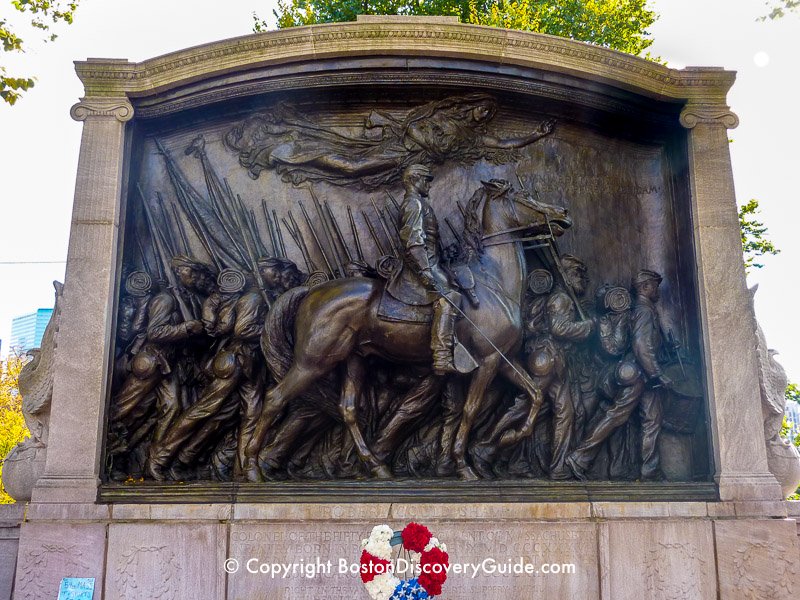
The Robert Gould Shaw and 54th Regiment Memorial, designed by renowned sculpture August Saint-Gaudens and considered perhaps his greatest monument, was unveiled in 1897 and honors the first African American regiment and their young white commander. It is located on the edge of Boston Common facing Beacon Street, and is almost directly across from the Massachusetts State House.
Less than 2 months after their departure from Boston, the 54th Regiment's 600 men led a doomed beachfront assault on Fort Wagner in Charleston, South Carolina where almost half their number were killed, wounded, or captured.
However, their valiant actions paved the way for thousands of other black men being accepted for combat, which President Lincoln later credited for helping the Union Army to gain the momentum needed to prevail.
The bravery of the regiment is also commemorated in the 1989 Academy winning movie "Glory," starring Morgan Freeman, Denzel Washington, and Matthew Broderick. Some movie scenes were filmed on Boston Common.
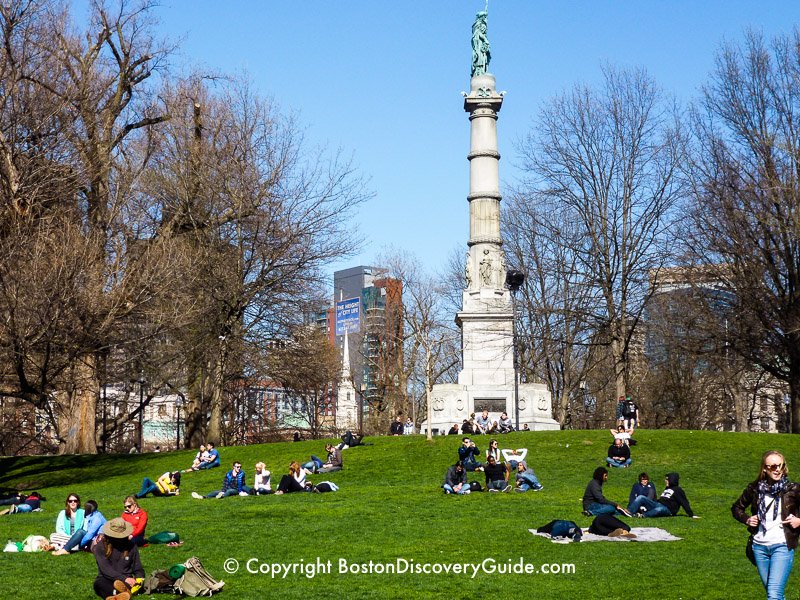
The Soldiers and Sailors Memorial graces Flag Staff Hill, the highest point on Boston Common, and honors those who died on land and sea for the Union during the American Civil War.
The beautiful neoclassical design features a white granite doric column topped with a bronze woman named America. She wears a crown with 13 stars, and holds a large American flag in her left hand. Her right hand holds a laurel wreath and sword.
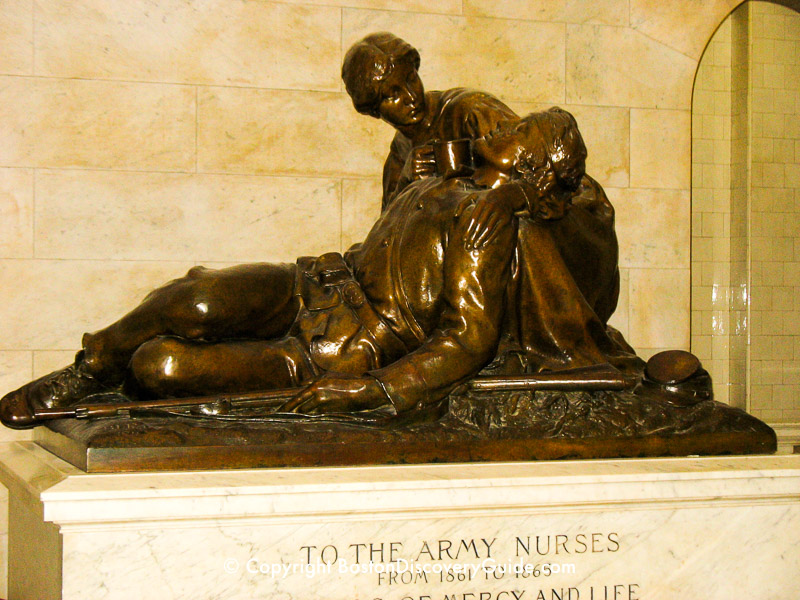
The Civil War Nurses Memorial honors Union Army nurses who cared for the wounded and dying in the American Civil War from 1861-1865.
Location of the Civil War Army Nurse Memorial: Massachusetts State House across from Boston Common, and just across the street from the Shaw Monument.
More about the memorials, sculptures, and art you'll find inside the State House
Garden of Flags
Commemorating those who have given their lives to defend the U.S. and our freedom since the Civil War
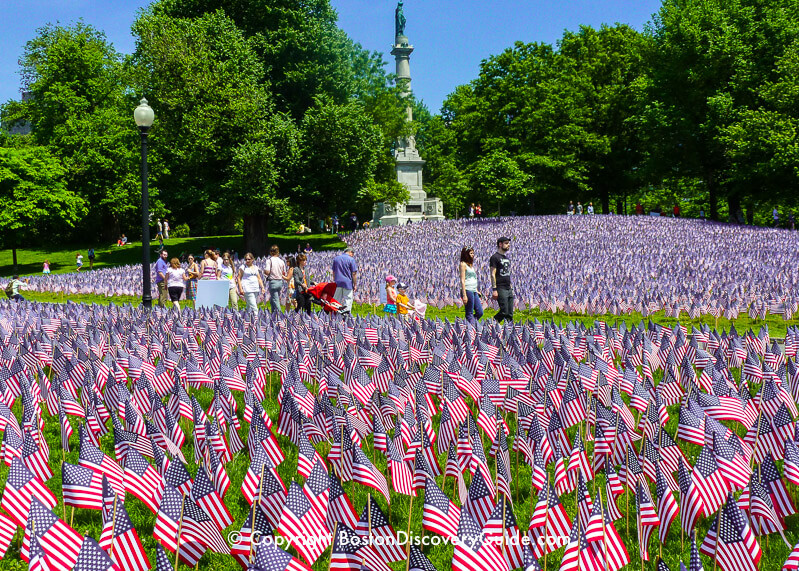
For 6 days through Memorial Day weekend each May, a Garden of Flags blankets Boston Common. The massive display of flag stretch as far as you can see, and serve as reminders of the magnitude of lives lost.
A special ceremony to honor Massachusetts service members killed in Iraq and Afghanistan takes place during this period.
Location: Boston Common near the Soldiers and Sailors Monument
More about the schedule for the remembrance ceremony and the Garden of Flags
World War I Memorial
Honoring those who fought and died in the "war to end all wars"
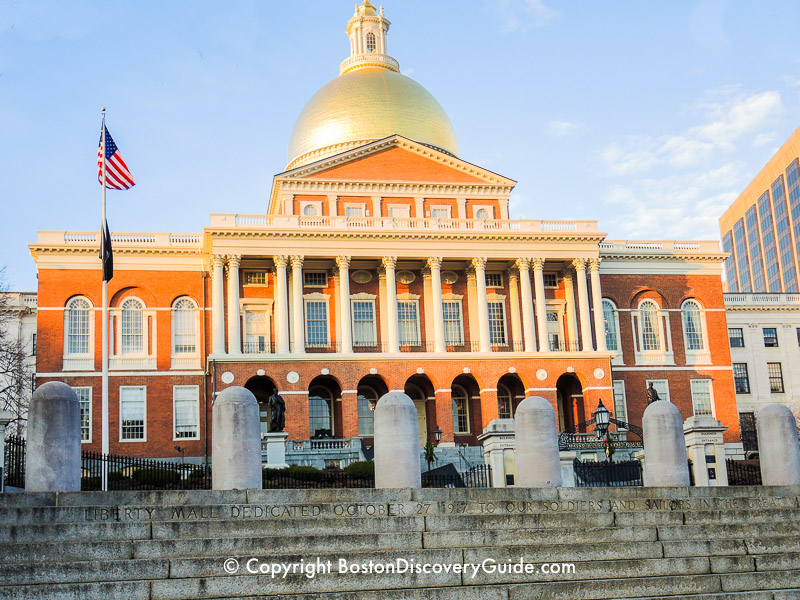
Surprisingly, in a city filled with war memorials and monuments, World War I commemorations are scarce.
See the steps at the edge of Boston Common leading up to the Massachusetts State House? They are dedicated to all the soldiers who fought in the "Great War." If you're looking for a World War I memorial in downtown Boston ... that's it.
Location: Boston Common, Beacon Street, next to the Robert Gould Shaw Memorial and across the street from the State House.
World War II Memorials
Commemorating those who fought in the Second World War
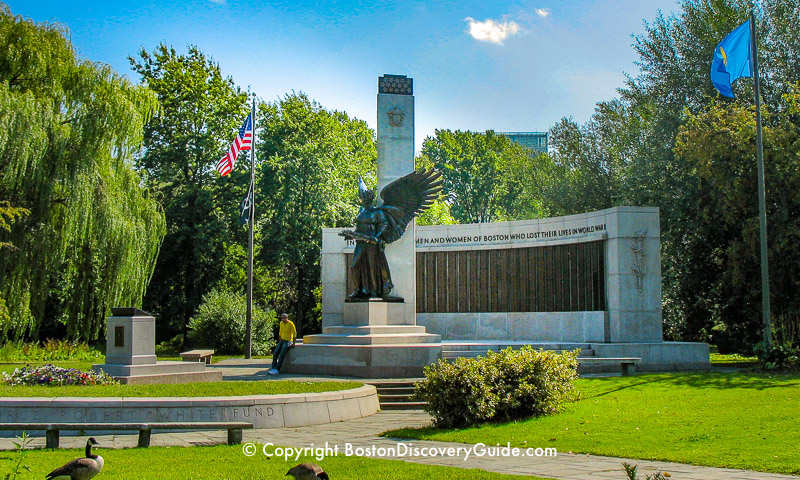
The World War II Memorial in Boston's Back Bay Fens is part of a grouping of 3 war memorials created by a fund established by Boston philanthropist George Robert White (you can see a statue of him in the Public Garden near the corner of Beacon and Arlington Streets) and called "Veterans Memorial Park."
The memorial is in a tranquil spot next to the Kelleher Rose Garden and Victory Gardens. The large bronze angel on the memorial seems to look out toward the reed-filled fens.
In June, you can smell the scent of roses in the air as you look at all the names of Boston service members who died in World War II.
Location: Back Bay Fens, Boston's Fenway neighborhood
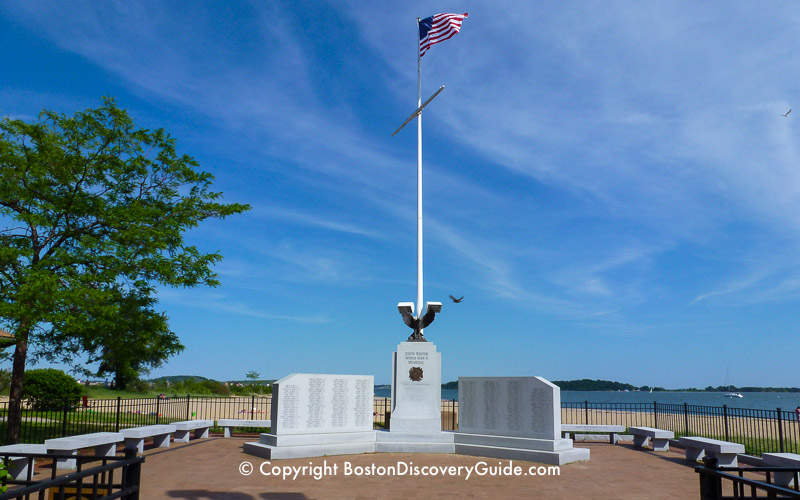
The South Boston World War II Memorial commands a position front of one of the most beautiful stretches of Pleasure Bay Beach leading out to Castle Island. Walk up close to it, and you'll see the names of the 216 South Boston residents who died fighting in World War II
Be sure to walk around to the back where you'll see General Omar Bradley's famous quote engraved in the granite: "Bravery is the capacity to perform properly even when scared half to death."
More about Castle Island and how to get there
Holocaust Memorial
In memoriam to those who perished ... in honor of those who survived
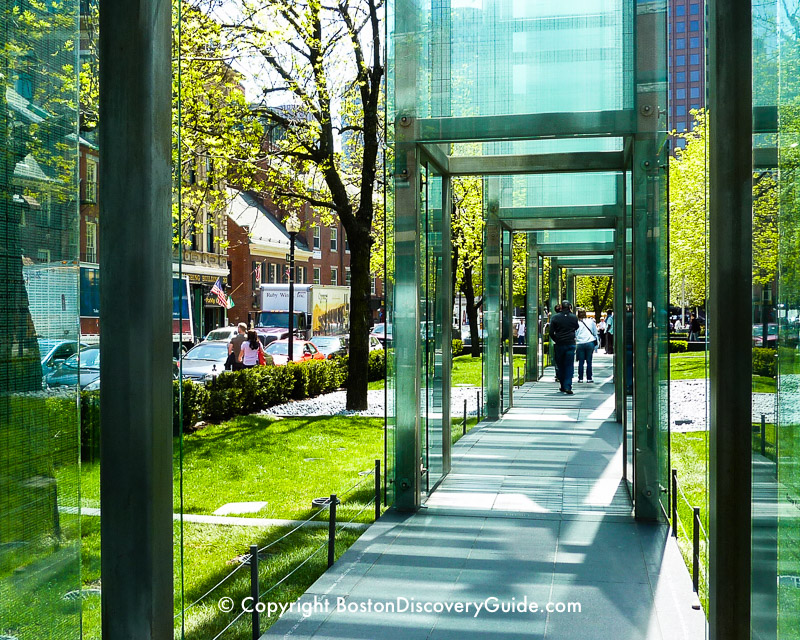
Boston area survivors of Nazi concentration camps led the effort to create the Boston Holocaust Memorial (officially called the "New England Holocaust Memorial").
The Memorial, located next to Boston's Freedom Trail, is dedicated to keeping alive the memory of the 6 million Jewish men, women, and children and the 5 million other people murdered by the Nazis from 1937-1945.
More about Boston's Holocaust Memorial
Korean War Memorials
Honoring those who fought and died in this "police action"
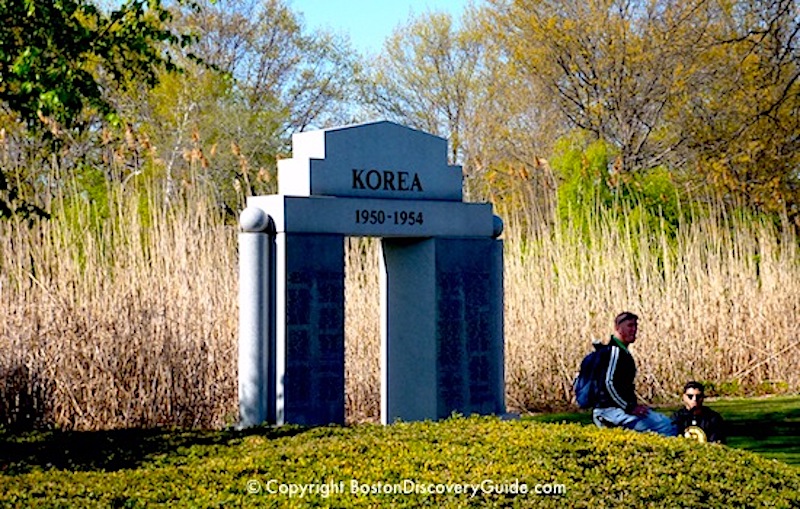
This Korean War Memorial commemorates those who died in the undeclared military action in Korea from 1950-1954. It is also in Veterans Memorial Park in Boston's Back Bay Fens, across from the World War II memorial.
Although you can't see it in this photo, there is a small plaza at the base of the memorial, with a map of Korea embedded in it.
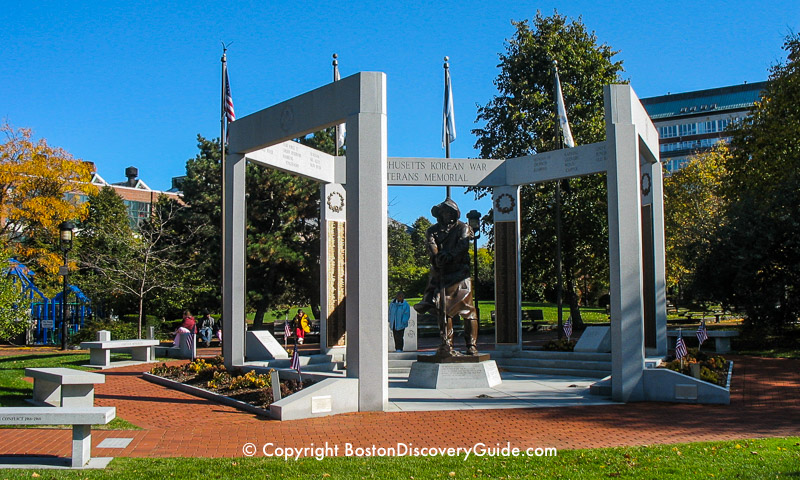
The Massachusetts Korean War Monument honors the 1,506 troops from throughout the state who died in combat during the Korean police action, and the 168 men who are still MIA.
Each of the six columns bear the names of fallen service members. Above, you can see the names of the major battles engraved in the granite.
Each of the bricks in the memorial pathway surrounding the statue honors one of the Massachusetts residents who served in the conflict.
Location: Charlestown Navy Yard - to get there, take the Charlestown Ferry from Long Wharf on the Downtown Boston Waterfront.
Martin Luther King "Free at Last" Memorial
Commemorating the fight for civil rights and racial equality
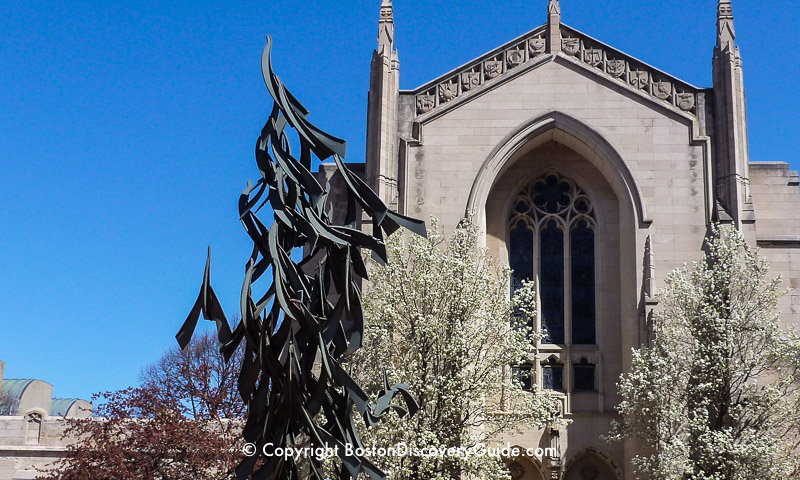
The Free at Last sculpture in front of Marsh Chapel at Boston University commemorates Dr. Martin Luther King, Jr., the great civil rights leader to completed a doctorate at BU in 1955 and went on to lead the fight for civil rights and racial equality in the 1960s. Dr. King's assassination in 1968 unleashed an eruption of anger as cities burned across the U.S.
Look at the cor-ten steel and granite work by sculptor Sergio Costillo up close, and you'll see a mass of individual birds. From afar, you see only a flock shaped like a single bird, flying up toward the sky.
Find out about Boston's annual remembrance ceremonies honoring Dr. King
Vietnam War Memorial
Remembering those who died in Southeast Asia
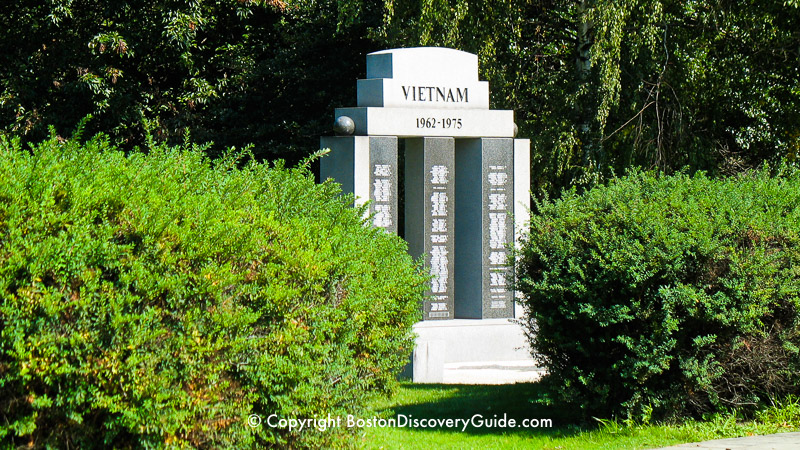
The Vietnam War Memorial bears the names of local men and women whose lives were lost during the conflict in Vietnam as well as in Cambodia and Laos.
Location: Veterans Memorial Park in Boston's Back Bay Fens.
Massachusetts Beirut Memorial
Honoring the peacekeepers
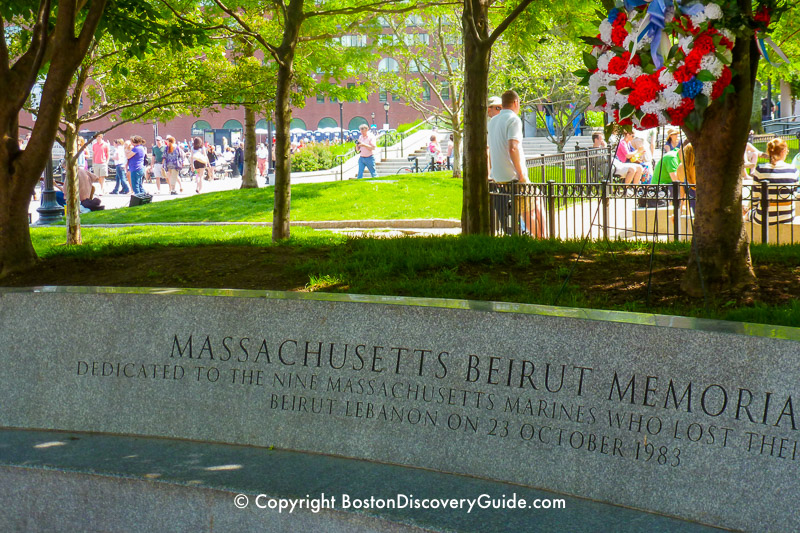
The Massachusetts Beirut Memorial commemorates the sacrifices of the nine Massachusetts Marines who were part of the U.N. peacekeeping force in Beirut, Lebanon when terrorists exploded bombs next to the barracks housing American and French troops.
Location: Christopher Columbus Park, next to the waterfront behind the Marriott Long Wharf hotel.
Old North Church Memorial Garden
Remembering those Lost in Operation Iraqi Freedom and Operation Enduring Freedom in Afghanistan
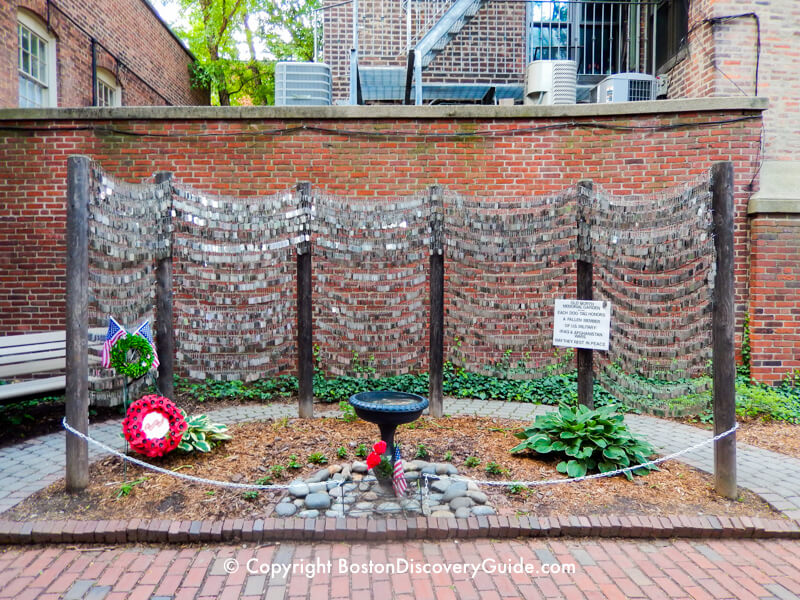
The Old North Church Memorial Garden, occupying a peaceful corner near where Paul Revere's lanterns once signaled the beginning of the Revolutionary War, was created in 2006 to honor American lives lost in the operations in Iraq and Afghanistan. Blank dog-tags (traditional military IDs) are hung on chains to create a haunting wind chime effect whenever there is a breeze. Each tag symbolizes a fallen American; currently, there are about 7,000, and more continue to be added.
You'll find additional symbols in the garden. Red flowers represent the sacrifices and bloodshed of war, while a single white flower symbolizes hope for peace. Stones around the fountain echo the tradition of leaving stones on Jewish graves as symbols of prayers for the dead. They are marked with the number of deaths of Massachusetts residents during each year, including those killed in the 9/11 attacks. Outside the Memorial Garden, you can see another rock garden honoring those who died in all American wars.
Location: 193 Salem Street, Boston's North End; the Memorial Garden is directly behind the church, and you can also approach it through Paul Revere Mall off Hanover Street - walk along the Freedom trail past the statue of Revere on horseback, and as soon as you see Captain Jackson's Historic Chocolate Shop, walk about 20 more feet and you'll see the garden on your right.
More: Old North Church website
Garden of Remembrance: 9/11 Memorial
Commemorating Massachusetts lives lost in the attacks on the U.S.
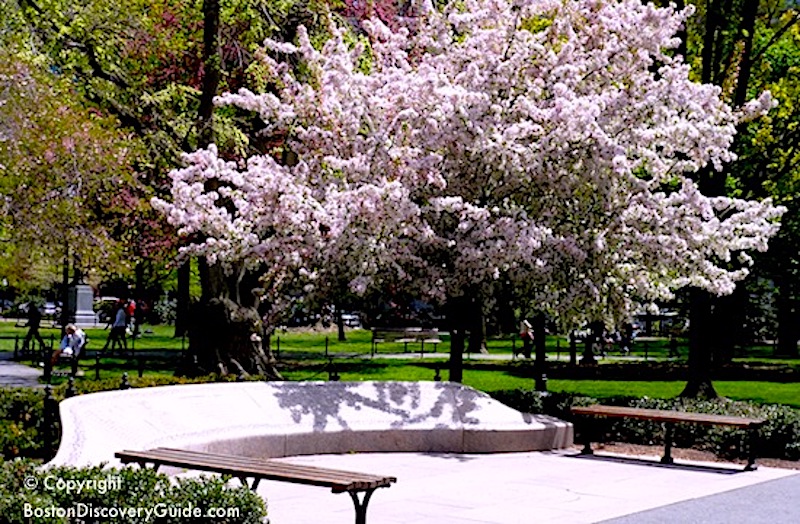
The Garden of Remembrance, Boston's memorial to the 206 people from Massachusetts or with strong ties to the state who died in the September 11, 2001 attacks on the United States, hugs the ground in a quiet spot of the Public Garden near the Arlington Street gate across from Commonwealth Avenue Mall.
Plants, flowers, and benches surround the pink granite stone memorial, designed by Victor Walker and put in place in 2004.
The memorial lists the names of those who died, and includes words by local poet Lawrence Homer: "Time touches all more gently here."
Sit on one of the benches for a few moments . . . you may feel the suspension of time.
Marathon Bombing Memorials
Tributes to those who died in this attack on our city ... and to those who saved others
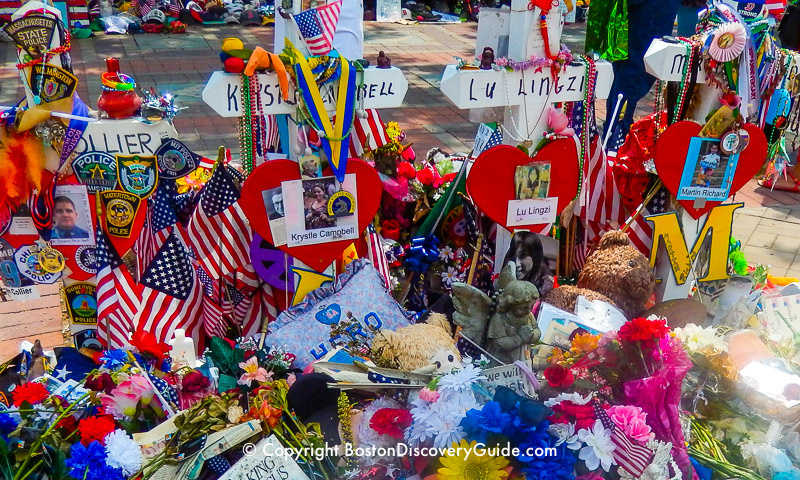
Martin Richard, Krystle Campbell, Lu Lingzi, Sean Collier
Within a day after bombs exploded near the Boston Marathon finish line on Patriots Day, April 15, 2013, spontaneous memorials began to blanket the barricades around Boylston Street.
Photos, flowers, stuffed animals, t-shirts, notes, baseball caps, balloons, flags...and above all, hand-written notes.
Eventually, predictions for heavy rain meant city archivists had to remove the memorials to the city archives. Someday, you will be able to see them again in a permanent memorial to those who died at the scene, and those who made sure that everyone else survived.
Boston Strong!
See more photos of the Boston Marathon memorials
Fallen Heroes Memorial
Honoring Massachusetts service members killed in Iraq and Afghanistan since September 11, 2001
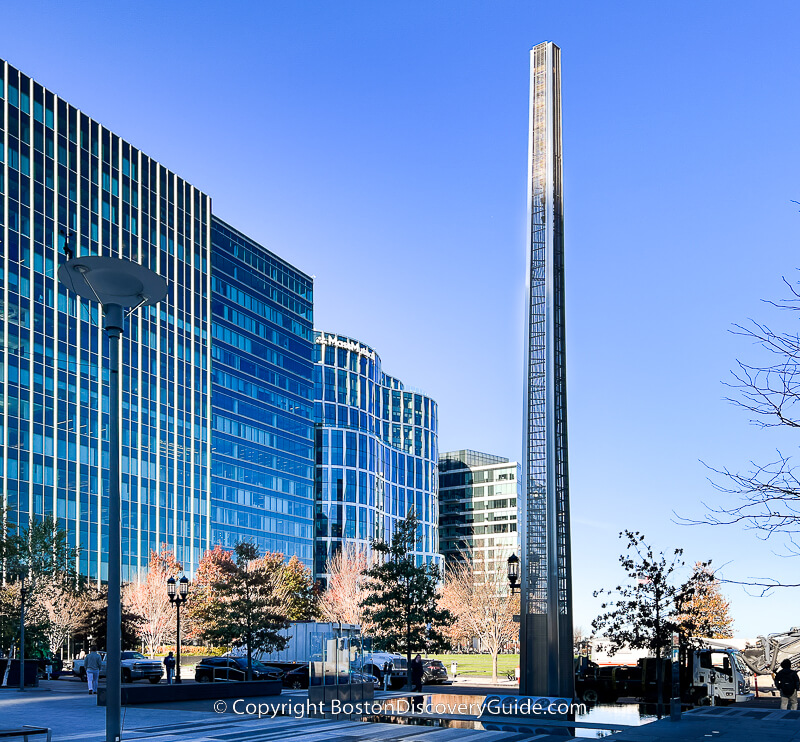
Located in Seaport Park (Seaport Blvd) overlooking the Harbor in the South Boston Waterfront neighborhood, the Fallen Heroes Memorial's obelisk soars 50 foot high, with its five sides symbolizing the five branches of U.S. Military Service.
Find more to see & do in Seaport
During the day, the tower reflects the waterfront's changing light, often seeming to sparkle if you're standing at a distance. At night, internal lighting makes it visible from different points around Downtown Boston and the Harbor.
Dedicated in 2016, this is Boston's newest war memorial.
Sadly, it is most likely not the last.
More to See in Boston
More Articles about Historic Places in Boston
- Boston's Freedom Trail - Find more sites to visit on Boston's famous Walk through History
- Beacon Hill - Explore the wonderful historic neighborhood near the Boston Massacre Site
- Faneuil Marketplace - Visit this popular shopping/dining/entertainment complex on the Freedom Trail
- Boston History - Want to know more? Our Boston history timeline makes it easy!
- Beacon Hill Hotels - Best places to stay in and near Beacon Hill
- More Top Boston Attractions - Find more interesting things to see and do in Boston


